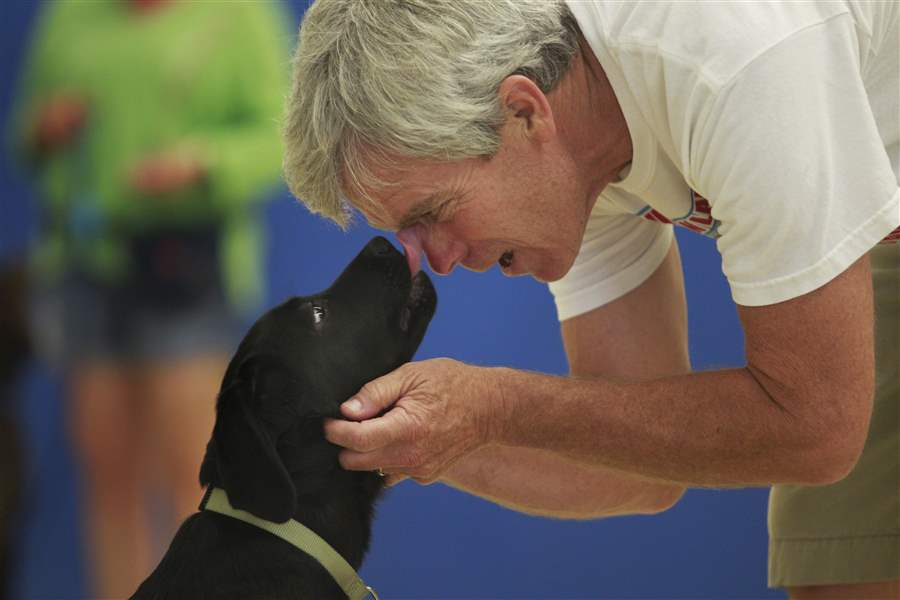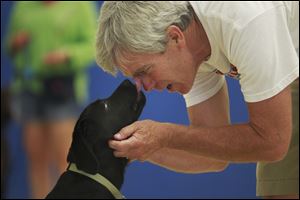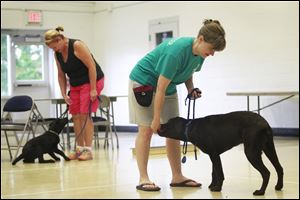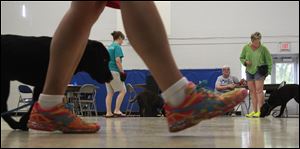
Sylvania organization trains dogs to aid the physically disabled
6/22/2014
Rainn, a 4-month-old lab, licks his owner's face, Gary White, during a recent training program at the Assistance Dogs of America Inc. campus in Sylvania.
The Blade/Isaac Hale
Buy This Image
Editor's note: This article has been updated to clarify Assistance Dogs for Achieving Independence is a program of The Ability Center of Greater Toledo.

Rainn, a 4-month-old lab, licks his owner's face, Gary White, during a recent training program at the Assistance Dogs of America Inc. campus in Sylvania.
In a perfect world, Assistance Dogs for Achieving Independence wouldn’t exist.
There would be no paraplegia or people with muscle atrophy, no adults plagued by balance issues or children with learning disabilities or autism.
In a perfect world, dogs would be dogs and people would enjoy them as such.
But this being an imperfect world, Sylvania-based ADAI, a program of the Ability Center of Greater Toledo, provides a service that fully-abled people take for granted. It helps those in need it cope with some of life’s most basic demands: walking down stairs, opening a refrigerator door, navigating the aisles of a busy market.
PHOTO GALLERY: Click here for more photos from a recent training session
On a Monday afternoon at the non-profit’s offices a mile north of Franklin Park Mall, hope is in the air. Several dogs lie amiably at the feet of their handlers, while a pair of cats slink around the room, not so much avoiding the dogs as ignoring them. Through another door is a room of kennels where four recent arrivals wait to be fed or begin their instruction.
It is a two year process from puppy to service dog, with the last six months the most intensive. This is when the dogs leave their foster homes – volunteers raise them from infancy through their first year – and take their final exams, as it were.
“We have anywhere between 40 and 50 dogs in our program at any given time, which means they can be anywhere from puppy and two years old, which is when they’re placed,” explains Jenny Barlos, Client Services Director for ADAI. “In our class for the summer we have six dogs (who are) in their final four months before placement.”

Foster parent Robin Agen-Blausey, left, prepares to give Ellen, her 19-week-old lab, a treat as foster parent Cara Bankey, right, gives a treat to Violet, a six-week-old lab.
ADAI does not train guide dogs for the blind or hearing-impaired; there are other programs for that. Instead, its dogs focus on assisting with physical handicaps, which demands a specific temperament. The vast number of dogs are Labrador and golden retrievers, and, in this summer class, one labradoodle (they’re hypoallergenic). Retrievers tend to be calmer, Ms. Barlos says, and not likely to take off at the first sign of a squirrel.
The impulse may be there, but the dog is trained to manage it.
The demand for assistance dogs outstrips their availability, so there is always a waiting list. ADAI will look at the needs of people on its list and train dogs for those specifics.
The organization has an annual budget of $385,000 to cover staff, vet bills, training and placement. Mostly its funding comes from grants, special events and donations.
ADAI acquires its dogs through breeder donations, rescue groups and occasionally even purchases them. The cost of providing a service dog isn’t cheap; ADAI estimates that it costs $18,000 to raise and train an animal. Clients and schools rarely pay that full amount thanks to a robust fund raising program.
ADAI is a mid-size program that places 20 dogs a year in Ohio, Michigan and Indiana. Sixty percent of the dogs fall into the service category while the rest are considered therapy dogs. They’re placed in schools to work with children with learning disabilities, or periodically hospices.
When a dog doesn’t make the cut it’s not discarded, says Ms. Barlos. It goes into the “Fabulous Flunkies” category for which there are no shortage of people wanting to adopt.
“About 70 percent of the dogs that come into the program make it all the way through the program and are placed,” she says. “Dogs (flunk out) for various reasons. It may be that they have too much anxiety going out, or we can’t get them to control themselves around birds or squirrels. We have a long waiting list of people who want to adopt dogs who have some basic training. Our percentage is better than the national average, which is about a 55 percent success rate.”
Training service dogs begins with the right breed and teaching upward of 40 commands, among them the “Help!” bark if the animal’s owner falls down or is incapacitated
“Labs and goldens are bred to retrieve, and that’s what we’re looking for,” says Kali Makula, Training Director for ADAI. “Also, their size. They are large enough to do the work, but not too big to get in the way when they’re out in public. They’re also easy to come by from breeders or shelters, which is good for us because we want a dog that we have easy access to.”
As for what makes a good dog trainer, Ms. Makula says it starts with patience.
“You’re dealing with both people and dogs, so patience is very important,” she explains. “You have to be a close observer of dog behavior as well as human-dog interaction. You want to be respectful and guide the dog as a parent would a child. They don’t need a lot of assertiveness, per se.”
When does she know if a dog will make the grade?
“We often know as early as 16 weeks, but we pretty much try to rule out everybody as much as we can by the time they’re a year old. They come in and we do a full temperament assessment. Rarely do we release a dog at the very end of training, but it does happen.”
While scientific surveys conflict on where dogs rank in terms of cognitive intelligence, few doubt their emotional IQ.
“They’re very intuitive, and once they’ve been placed with a person for a while they start to anticipate a person’s needs even before it’s requested,” says Ms. Makula. “Or they’ll be creative and help a person in a way we didn’t even train them . They really learn to pick up on our emotions and our body language in a very unique way.”
Key to a service dog’s development is the foster parent program, which begins around eight weeks and continues until it‘s ready for its final exams. Debby Kelly of Perrysburg has been a foster parent for nine years, including her current black lab puppy, Danny.

Foster parent Robin Agen-Blausey, front, walks with Ellen, a 19-week-old lab, as foster parent Cara Bankey, left, walks with Violet, a six-month-old lab, and foster parent Lee Ann Lyon, right, walks with Skippy, a six-month-old lab.
Her volunteer work began out of sadness, she says, but has been more joyful than she could have imagined.
“I first got involved after my own dog of 12 years, a Siberian husky, died and I didn‘t think he was replaceable,” she recalls. “I had often seen assistance dogs marching in Perrysburg parades, so I gave them a call and they told me more about the program and it sounded like exactly what I wanted to do.
“I’m expected to teach them good dog manners and expose them to a lot of social situations. When they‘re ready we take them out in public: grocery stores, banks, libraries; we introduce them to children and old people, people in uniform, anything they might meet when they’re out in public and not be startled. We don‘t want them to be protective, which is what a lot of people think. We need a dog that is going to be friendly with everyone and devoted to the person (he’s assigned to).”
Not all dogs graduate, of course, as happened at least once, Ms. Kelly says.
“With my second dog they found that his hips had a tendency to be a little loose so he didn‘t make (the program), and he was adopted by me. He goes to work with me at a senior center every day.”
For all the joys of fostering a service dog, she admits there is also sadness when letting them go to their new home.
“You get very attached to them and it happens very quickly,” says Ms. Kelly. “The only way I can do it is to turn right around and take another one home with me to ease terrible pain of giving them up. When you see the (disabled) person receive that dog it’s hard, but it‘s a good hard.”
A “good hard” largely describes how everyone associated with ADAI feels as they strive to make a difference.
“It’s the best job I’ve ever had,” says Ms. Barlos of her seven years with ADAI. “You’re seeing immediate benefit for people. They have a dog who can help them with tasks, but they also have a companion. It’s a huge transformation in people and our goal has always been to create independence.”
To find out more about Assistance Dogs for Achieving Independence call 419-885-5733 or visit www.ADAI.org